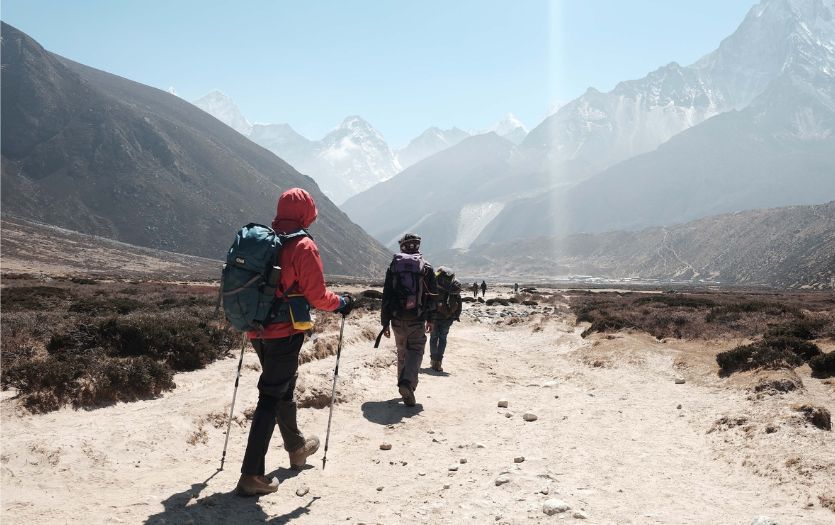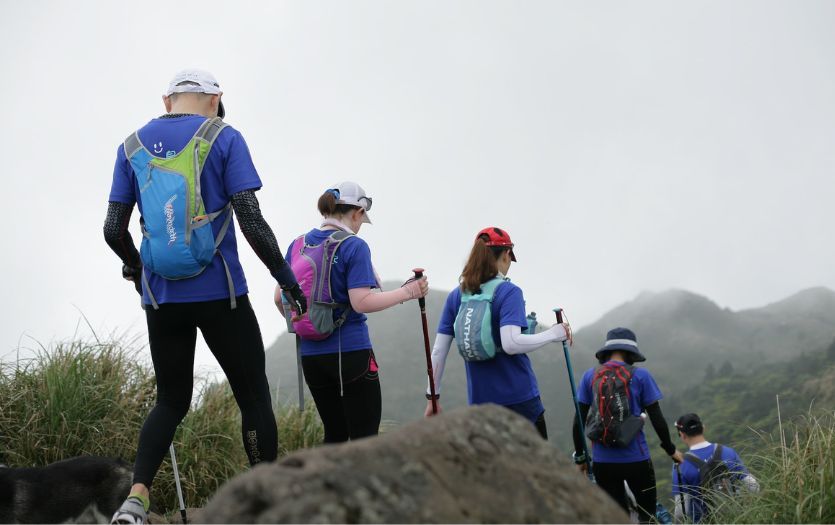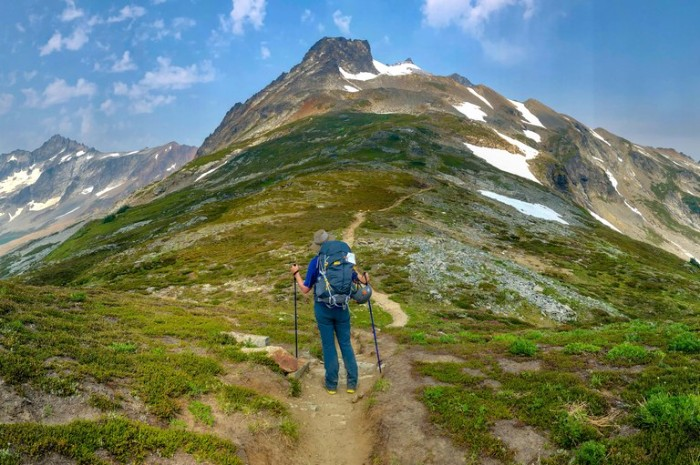Hiking in Style with Trekking Poles (Know Why to Use them and How to Size them)
Discover the benefits of using trekking poles on your next hike. Learn why they're essential for a comfortable and safe outdoor experience, and how to size them for the best fit. Upgrade your hiking game with style and comfort - read our blog on hiking with trekking poles now!
Are you ready to take your hiking experience to the next level? Do you want to feel like a pro as you trek through nature's wonders, with all the confidence and ease of an experienced hiker?
Well then grab your favorite pair of trail shoes and get ready for a life-changing journey — because today we're talking about Trekking Poles!
With Trekking Poles, it doesn't matter if this is your first hike or your hundredth. Not only will they help make sure that every step is taken safely, but they can also provide comfort and support along the way. Plus, having them on hand gives you an added sense of style while exploring some of Mother Nature’s most stunning locations.
So join us now as we explore why trekking poles are essential for any outdoor enthusiast looking to hit the trails in style!
Why Use Trekking Poles

Using trekking poles can make a huge difference in your outdoor ventures, no matter the terrain. Not only do they provide extra support and balance on steep hills, but they also help conserve energy over long-distance hikes by taking some of the burdens off your joints and muscles.
Used properly in a rhythmic motion, trekking poles allow you to maintain a more natural posture with less strain on your back and legs. The special tips also scrape away rocks and debris that would otherwise cause you to trip or stumble inadvertently.
Trekking poles come in different sizes for various heights and adventures so depending on your needs there's definitely an option out there for you. Picking up a pair of good-quality poles is an investment that will pay off in enjoyment, pain-free muscles, and better overall performance when outdoors.
How to Size Trekking Poles Correctly

Sizing a pair of trekking poles correctly is essential for an enjoyable and safe hike. To properly size your trekking poles:
1. Stand upright in a relaxed position with your arms at the side of your body.
2. Extend one arm up till it's parallel with the ground (this will be your measurement arm).
3. Measure from the ground to where you are able to reach comfortably with your fingers (not including thumb) while keeping that arm extended upwards—this will give you your pole height measurement in centimeters or inches, depending on what measurements were used when sizing the pole itself.
4. Choose a pair of poles whose length should never exceed this measurement—the shorter end should reach just underneath the armpit when standing upright in that same relaxed position as before.
This is just a general rule if you are getting an adjustable length or a telescopic pole. But if you need to pick a fixed-length pole, it should depend on the terrain you will be hiking in.
No matter what type of terrain you're in, always make sure that your elbows are bent at about 90 degrees when gripping your trekking poles. This ensures that your arms are absorbing shock from any uneven ground rather than your feet and legs taking all of the impacts.
To determine your hiking pole size, tuck in your arms along the sides of your body with forearms parallel to the ground and fists facing each other. Measure from the ground up to the center of your fist and select trekking poles that are approximately 2-4 inches higher than this height for optimal results.
How Long Should Trekking Poles be on Different Terrains
Hiking poles can make all the difference when it comes to staying stable and sturdy on uneven or tricky terrain. Knowing how to set the length of trekking poles for the terrain you are tackling is essential for your safety. Here's how:
- If you're traveling across flat land, adjust the poles so that your arms are at a 90-degree angle when holding them in line with your torso.
- In hilly areas, shorten the pole edge slightly so you have more leverage as you move up slopes without straining your hands.
- When crossing streams or other water features, adjust your poles to their shortest setting so they don't drag in the water and cause a potential hazard.
- For rough and rocky terrains, lengthen your poles an extra inch or two so they provide stronger stability underfoot and off-road surfaces.
- During descents, adjust poles to an even longer length (for extra leverage) and use them to help absorb shock from each step downwards.
- Finally, always keep one eye on your pole length while trekking, and be prepared to make adjustments according to changing terrain conditions throughout your journey!
When trekking with telescopic poles, make sure to pay attention to the slope of your terrain and adjust accordingly. Take extra care when locking them into position, and avoid modifying their length during your journey!
Now that you have sized yourself correctly for some new trekking poles, remember to adjust them often as needed when changing elevation or terrain type to ensure continued comfort throughout an outing and get all those wonderful benefits they provide!
Different types of trekking poles
Depending on the materials used, mostly you can have:
- Carbon Fiber Poles – These are ultralight poles designed for lightweight backpacking and minimalistic hiking. These are perfect for long-distance treks as they provide excellent support with minimal fatigue to users.
- Aluminum Poles – These durable poles offer strong support when traversing tricky terrain, such as rocky or uneven surfaces. Aluminum or aluminum alloy poles are comparatively heavier than carbon poles.
- Wooden Poles – These are made with sustainable materials and are often handcrafted, but they are not very commonly used. They provide a classic look and feel to any trek, but they are not as lightweight or durable as other types of poles.
- Fiberglass Poles: This material is less expensive than carbon fiber and is still lightweight. However, it is not as strong as carbon fiber and can be more prone to bending. They are not ideal for tricky terrains.
- Titanium Poles: These are the strongest poles you can get and are also very light. However, it is also the most expensive material for trekking poles and is not as commonly used as the other materials.
Depending on their adjustability features they can further be classified into:
Adjustable Trekking Poles
From short hikes and backpacking trips to more strenuous treks, these poles are the most popular and versatile option for outdoor enthusiasts. These poles boast a collapsible or telescopic design, allowing them to be effortlessly modified and locked in your desired size due to their structure of one section extending from within another.
Made from lightweight yet durable materials such as aluminum and carbon fiber, one of the key benefits of adjustable trekking poles is that they can be used by a wide range of people, regardless of their height. Additionally, they are versatile and can be adjusted to suit different terrain types and conditions.
Fixed Length Poles
These poles are specifically designed for specific activities such as nordic walking or snowshoeing, coming with a set size that cannot be adjusted. Unlike adjustable trekking poles, these poles lack adjustability but they do offer some advantages.
These poles are great for fast-paced excursions or travel; they also tend to last longer due to their sturdiness – your fixed-length pole is less prone to malfunctioning than its adjustable counterpart!
Folding Trekking Poles
Foldable poles feature sections that fold away neatly into a small package that can be secured with a strap or packed into a bag. Notable features include quick-release straps for increased convenience, as well as ergonomic handles to improve comfort while walking.
A folding pole is a great choice for those seeking support while on their journey, yet also desire portability when they're not in use. These poles are great as walking poles for flat terrain.
Depending on your individual needs, the trekking pole grips, shafts, and tips can be modified and utilized to make certain activities a breeze. For example...
- Padded trekking poles – though now it is a common feature in most trekking poles and you will see cushioned grips for extra comfort during longer treks or hikes over uneven terrain.
- Shock Absorbing Poles - these are designed with built-in dampers that absorb the impact from each footstep taken, resulting in improved comfort and less fatigue on longer hikes.
- Alpine ski poles – designed with a pointed tip and wide shaft for improved stability when skiing in the snow.
- Nordic Walking Poles - these poles are comparatively shorter, lighter with slimmer profiles, and have wrist straps. They come with a special grip and are used to generate a pushing motion, keeping the hands straight (unlike other hiking poles). In this technique, both the right pole and the left pole are held at an angle of 45 degrees to the ground behind the hiker which allows the user to walk more efficiently.
- Hiking staff – perfect for balance support while walking through wilder environments (e.g., forest tracks).
Take a look at the video below, to understand more about the nordic poles:
How to Attach Trekking Pole to Backpack
Trekking poles can be a great way to help support your body while out on the trail. Knowing how to properly attach trekking poles to your backpack is essential for ensuring they are secure and won't cause any injury during your journey. Here's what you need to know:
- Start by finding the adjustable straps and loops located on the back of your backpack. These are designed specifically for attaching trekking poles or other accessories.
- Attach one end of your trekking pole onto either the loop or strap and then pull the excess strap through until secure. Do this for both left and right poles, making sure each is securely fastened in place.
- Once attached, adjust the hook-and-loop straps around each pole until nice and tight - this will prevent them from rattling or shifting during movement.
- Finally, when packing up before setting off, always make sure that all poles are packed away in their correct locations on the pack – this will help ensure that you don't trip over them accidentally!
If your backpack doesn't have any loops for attaching your trekking poles, you can still do it with some simple hacks. Here's how:
- Buy towel clips – Simply clip one end of the trekking pole onto one side of the clip, then attach the other end onto an available loop or strap on your pack.
- Use carabiners– Carabiners are small metal loops used for fastening equipment and supplies together, which make them ideal for attaching trekking poles to a pack. Run some paracord through the loop at the bottom of each pole and then link them through whichever straps work best for your pack design.
- Attach with bungee cords– Bungee cords are another quick and simple solution for connecting trekking poles to backpacks. Just run one end of each pole through a cord loop and then tie it off securely against any available loops or straps on your bag.
Other Uses
As Tent Poles
If you're out camping and your tent poles break, a trekking pole can be used as a replacement. Simply adjust the length to fit your tent and you're good to go, you can even skip your dedicated tent poles completely with adjustable trekking poles!
Building shelter
Many hikers carry a lightweight collapsible tarp with them on their journeys, and trekking poles can come in handy when setting up a tarp shelter! Simply attach the tarp material securely around the poles and you’ll have a sturdy shelter in no time!
Fishing rod holder
If you’re fishing along with your hike, then having your hands free is beneficial – so why not use those trusty trekking poles? They make great holders for fishing rods while waiting patiently for that next bite!
Emergency splints
Trekking poles are made from tough materials, which makes them ideal for creating makeshift splints when needed during an emergency. You can use one as a support brace for broken limbs or even create an entire stretcher using two trekking poles and a sleeping bag or blanket!
Winch
If you need to pull a heavy load up a steep incline, a trekking pole can be used as a winch. Simply attach a rope to the end of the pole and use your body weight to help pull the load up.
Final Thought
Trekking poles are a versatile and essential tool for any hiker or outdoor enthusiast. Not only do they provide support while on the trail, but they can also be used in a variety of ways to make your journey more enjoyable and efficient. So next time you’re packing up before leaving home, don't forget to grab those trusty trekking poles – they just might save the day!
And to make your job easier we have compiled a list of the best trekking poles, especially for hunters carrying heavy loads. Tap the button below and check out some of the most durable and reliable trekking poles that you can buy.


